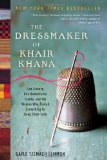
Five Sisters, One Remarkable Family, and the Woman Who Risked Everything to Keep Them Safe
Review posted November 29, 2011.
Harper, 2011. 256 pages.
2011 Sonderbooks Stand-out: #5 Biography
The Dressmaker of Khair Khana tells the story Kamila Sidiqi and how she kept her family of sisters -- and many of their neighbors -- going when the Taliban came.
Kamila got her teaching certificate in 1996, just before the Taliban came. She'd gone to classes despite the war. But with the Taliban in charge, she couldn't teach. Her father and oldest brother had to leave Kabul, for fear of getting targeted by the Taliban. She and her sisters had to stay inside, and could only leave the house in full chadri with a male relative escort. The situation in Kabul got worse and worse.
This is what I have to figure out, Kamila thought to herself. I need to find something I can do at home, behind closed doors. I need to find something that people need, something useful that they'll want to buy. She knew she had very few options. Only basic necessities mattered now; no one had money for anything else. Teaching school might be an option, but it was unlikely to earn her enough money, since most families still kept their girls at home out of fear for their safety. And she certainly didn't want her income to depend on an improvement in the security situation.
Kamila spent long days thinking about her options, considering which skills she could learn quickly that would also bring in enough afghani to make a difference for her family. And then it came to her, inspired by her older sister Malika, who, along with being a great teacher, had over many years developed into a talented -- and sought-after -- seamstress. Women from her neighborhood in Karteh Parwan loved her work so much that Malika's tailoring income now earned her almost as much as her teacher's salary. That's it, Kamila thought. I'll become a seamstress.
There were many positives: she could do the work in her living room, her sisters could help, and, most important of all, she had seen for herself at Lycee Myriam that the market for clothing remained strong. Even with the Taliban in power and the economy collapsing, women would still need simple dresses. As long as she kept quiet and didn't attract unnecessary attention, the risks should be manageable.
Kamila faced just one major obstacle: she had no idea how to sew.
This book tells the compelling story of how Kamila faced that, and many other obstacles that were by no means minor, and built a thriving business that even helped other neighboring families without men in charge.
I like the author's summary at the end of why Kamila's story is so important:
Brave young women commit heroic acts every day, with no one bearing witness. This was a chance to even the ledger, to share one small story that made the difference between starvation and survival for the families whose lives it changed. I wanted to pull the curtain back for readers on a place foreigners know more for its rocket attacks and roadside bombs than its countless quiet feats of courage. And to introduce them to the young women like Kamila Sidiqi who will go on. No matter what.
